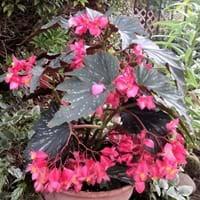Life Span
Perennial
Perennial
Type
Flowering Plants, Fruits, Trees
Tender Perennial
Origin
Central America, Europe, North America
South America, Brazil
Types
Not Available
Begonia grandis, Begonia obliqua
Number of Varieties
Not Available
Habitat
Hedge, Scrubs, Woods
Cold Regions, subtropical regions
USDA Hardiness Zone
4-8
10-15
AHS Heat Zone
Not Available
12-1
Sunset Zone
Not Available
H1, H2, 23, 24
Habit
Not Available
Upright/Erect
Flower Color
White
Red, Coral
Flower Color Modifier
Not Available
Bicolor
Leaf Color in Spring
Dark Green
Green
Leaf Color in Summer
Green
Green
Leaf Color in Fall
Brown, Green, Light Yellow
Green
Leaf Color in Winter
Not Available
Light Green
Leaf Shape
Oblong
Wing shaped
Plant Season
Summer
Spring, Summer, Fall, Winter
Sunlight
Full Sun, Partial shade
Full Sun, Partial Sun, Partial shade
Growth Rate
Medium
Medium
Type of Soil
Loamy
Loam, Sand
The pH of Soil
Neutral
Acidic, Neutral
Soil Drainage
Well drained
Well drained
Bloom Time
Fall, Summer
Indeterminate
Tolerances
Drought
Drought
Where to Plant?
Ground
Container, Ground
How to Plant?
Grafting, Seedlings, Transplanting
Cuttings
Plant Maintenance
Medium
Medium
Watering Requirements
Medium
Average Water Needs, Do Not over Water, Requires regular watering
In Summer
Lots of watering
Lots of watering
In Spring
Moderate
Moderate
In Winter
Average Water
Average Water
Soil pH
Neutral
Acidic, Neutral
Soil Type
Loamy
Loam, Sand
Soil Drainage Capacity
Well drained
Well drained
Sun Exposure
Full Sun, Partial shade
Full Sun, Partial Sun, Partial shade
Pruning
Prune when plant is dormant, Remove dead or diseased plant parts
Pinch Tips, Pruning will encourage new growth, Remove damaged leaves, Remove dead branches, Remove dead leaves
Fertilizers
All-Purpose Liquid Fertilizer
fertilize in fall, fertilize in spring, High potassium diluted feed of 5-10-5
Pests and Diseases
Aphids, Curculio occidentis, Japanese Beetles, Leaf Rollers, Leafminer, Mites, Red blotch, sawflies, Scale, Stink bugs
Red blotch
Plant Tolerance
Drought
Drought
Flower Petal Number
Single
Single
Foliage Texture
Medium
Coarse
Foliage Sheen
Matte
Matte
Attracts
Not Available
pollinators, Whiteflies, Wildlife
Allergy
Digestive Problems, Respiratory problems
Not Available
Aesthetic Uses
Showy Purposes
Showy Purposes
Beauty Benefits
Beautiful Skin
Not Available
Edible Uses
Yes
Insignificant
Environmental Uses
Food for birds
Air purification
Medicinal Uses
Anthelmintic, Antibacterial, Astringent, Hypnotic, Laxative, Refrigerant
Conjuctivitis, Headache, Mouth Sores, Sore Eyes, Sore throat, Treatment of ulcers
Part of Plant Used
Fruits
Flowers, Leaves, Root
Other Uses
Edible syrup, Jam, Jelly, Used As Food
Container, Used for its medicinal properties
Used As Indoor Plant
No
Yes
Used As Outdoor Plant
Yes
Yes
Garden Design
Not Available
Container, Feature Plant, Houseplant, Mixed Border, Tropical
Botanical Name
Malus sylvestris
BEGONIA coccinea
Common Name
European crab apple
Angel Wing Begonia
In Hindi
european crab apple
Angel wing begonia plant
In German
Der Holzapfel, Europäischer Wildapfel
Engel Flügel Begonie Pflanze
In French
Le Boquettier, le Pommier sauvage ou Pommier des bois
Ange aile plante bégonia
In Spanish
Malus sylvestris, el Manzano silvestre, manzano silvestre europeo
Ángel planta de begonia ala
In Greek
Ευρωπαϊκή μήλο καβουριών
Άγγελος φυτού Begonia πτέρυγα
In Portuguese
Malus sylvestris
Anjo planta Begónia da asa
In Polish
Jabłoń dzika
Anioł skrzydło begonia roślin
In Latin
european crab apple
Angelus pars plantae Begonia
Phylum
Magnoliophyta
Magnoliophyta
Class
Magnoliopsida
Magnoliopsida
Family
Rosaceae
Begoniaceae
Clade
Angiosperms, Eudicots, Rosids
Angiosperms, Eudicots, Rosids
Tribe
Not Available
Not Available
Subfamily
Not Available
Caesalpinioideae
Number of Species
Not Available
Not Available
Importance of European Crab Apple and Angel Wing Begonia
Want to have the most appropriate plant for your garden? You might want to know the importance of European Crab Apple and Angel Wing Begonia. Basically, these two plants vary in many aspects. Compare European Crab Apple and Angel Wing Begonia as they differ in many characteristics such as their life, care, benefits, facts, etc. Every gardener must at least have the slightest clue about the plants he wants to plant in his garden. Compare their benefits, which differ in many ways like facts and uses. The medicinal use of European Crab Apple is Anthelmintic, Antibacterial, Astringent, Hypnotic, Laxative and Refrigerant whereas of Angel Wing Begonia is Conjuctivitis, Headache, Mouth Sores, Sore Eyes, Sore throat and Treatment of ulcers. European Crab Apple has beauty benefits as follows: Beautiful Skin while Angel Wing Begonia has beauty benefits as follows: Beautiful Skin.
Compare Facts of European Crab Apple vs Angel Wing Begonia
How to choose the best garden plant for your garden depending upon its facts? Here garden plant comparison will help you to solve this query. Compare the facts of European Crab Apple vs Angel Wing Begonia and know which one to choose. As garden plants have benefits and other uses, allergy is also a major drawback of plants for some people. Allergic reactions of European Crab Apple are Digestive Problems and Respiratory problems whereas of Angel Wing Begonia have Not Available respectively. Having a fruit bearing plant in your garden can be a plus point of your garden. European Crab Apple has showy fruits and Angel Wing Begonia has no showy fruits. Also European Crab Apple is flowering and Angel Wing Begonia is flowering. You can compare European Crab Apple and Angel Wing Begonia facts and facts of other plants too.





